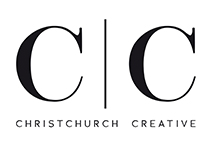Imagine a world where your content not only captivates your audience but also ranks high on search engines, driving a steady stream of targeted traffic to your website. This dream can become a reality with the power of SEO copywriting. By combining the art of persuasive writing with search engine optimisation techniques, at Christchurch Creative we create content that both engages your readers and appeals to search engine algorithms. Here, we will reveal some of the secrets of SEO copywriting and how we can transform your content into a performance powerhouse.
The art of copywriting: core principles

This is our director Sarah’s studio where she handcrafts SEO blog content for a variety of clients in the interior and lifestyle sectors
Great copywriting is like a skilled conductor, orchestrating a symphony of words that will resonate with the reader and guide them towards a desired outcome. At its core, SEO copywriting revolves around powerful persuasion techniques, crystal clear clarity and brevity, and the effective use of call-to-action (CTA) elements. Mastering these principles allows you to craft content that is informative, delightful, ranks well in Google search results, and drives conversions. To achieve this, consider working with experienced digital journalists who will use SEO copywriting tips and handcraft these into the writing process.
While the art of copywriting has been around for a long time, its importance has really grown in the digital era. With millions of websites vying for attention, creating high-quality content that stands out has become more crucial than ever. The fusion of SEO principles with persuasive writing enables your content to appeal to both search engines and human readers, thus maximising visibility and engagement.
Persuasion techniques

One of the most powerful weapons in our copywriting arsenal is the ability to persuade. Mastering persuasion techniques can help us to connect with your audience on a deeper level, addressing their pain points and influencing their actions. In short, we skilfully blend psychology and copywriting to create captivating content.
So, how do we harness the power of persuasion in our copywriting? Here are some key components:
- Storytelling
- Emotional appeal
- Psychological triggers
- Conveyance of authority
- Speaking the customer’s language
- Factual proofs
Understanding and effectively addressing your target audience’s pain points are key steps to building trust, forging connections, and guiding readers towards a desired action.
Clarity and brevity
In the world of copywriting, less is often more. Clarity and brevity are essential for ensuring that your message is easily understood and concise, making complex concepts more accessible and enjoyable to read. When we produce content for you, which is clear and to-the-point, it maximises conversion rates by focusing on the target keyword and its relevance to the audience.
One effective method to achieve clarity and brevity is the inverted pyramid method. This format presents the most important information first, followed by supporting details, and finally, the background information. Presenting readers with immediate information can help to enhance dwell time, which ultimately improves your search engine rankings.
Call-to-action (CTA)
We find that a well-crafted call-to-action (CTA) is like a guiding star, leading your readers towards a specific action, such as signing up for a newsletter or making a purchase. CTAs are essential for achieving successful conversion optimisation, helping to transform passive readers into active participants.
To create effective CTAs, we make sure they are easy to understand, use motivating language, and we place them in visible locations for maximum impact. Remember, a powerful CTA can be the difference between a reader leaving your website or taking the desired action, so we invest time in crafting compelling CTAs that drive results.
SEO copywriting fundamentals

The days of typewriters are long gone and digital content creation enables our team to handcraft SEO blog posts to raise brand awareness
Now that we’ve explored the art of copywriting, what are the SEO copywriting fundamentals? Well, to create content that ranks well in search results and resonates with your audience, we need to master the essentials of keyword research, understand search intent, and optimise your content for both search engines and human readers.
The combination of persuasive writing prowess, the skills of qualified journalists and SEO best practices enables us to avoid pitfalls like keyword stuffing, creating high-quality content that appeals to both search engine algorithms and your target audience. Let’s delve deeper into these fundamentals, so you can discover how we can elevate your SEO copywriting game.
Keyword research
Keywords are the building blocks of SEO copywriting. They help search engines understand the topic and relevance of your content, ultimately determining its position in search results. Keyword research is the process of identifying relevant keywords and high-performing keywords to target in your content, using our preferred tools.
Thorough keyword research enables us to:
- Discover the exact phrases your target audience uses in their searches
- Create content that addresses their needs
- Improve your search rankings
- Ensure that your content is engaging and valuable to your readers.
With a powerful keyword research tool at our disposal, we can unlock a treasure trove of insights and opportunities to optimise your content for both search engines and human readers.
Search intent
Behind every search query lies a purpose, a reason for the user’s quest for information. This is known as search intent, and it plays a crucial role in determining the relevance of your content to a user’s needs. Understanding search intent enables you to create content that satisfies the user’s query and achieves high rankings in search results.
There are four main types of search intent:
- Informational – when a user is looking for information or answers to a question
- Navigational – when a user is looking for a specific website or web page
- Commercial – when a user is looking for information about a product or service with the intention to make a purchase
- Transactional – when a user is ready to make a purchase or take a specific action
To create content that resonates with your target audience and ranks well in search results, it’s essential to understand and address the specific intent behind each keyword. This ultimately helps us to craft content that not only engages your readers but also satisfies their needs and propels them towards the desired action.
Content optimisation
Content optimisation is the process of fine-tuning your SEO content to appeal to both search engines and human readers. This involves strategically incorporating targeted keywords, optimising meta tags, and ensuring your content is well-structured and engaging.
Content optimisation enhances visibility in search results, attracts more organic traffic, and creates a better user experience for your readers. Whether we’re crafting a blog post, a product description, or a landing page, content optimisation is a crucial step in the SEO copywriting process that helps us to reach your target audience and achieve your marketing goals.
Crafting compelling headlines and meta descriptions

Maybe you can ‘judge a book by its cover’ – we create headlines and meta descriptions which users will see and want to click on your content
They say you can’t judge a book by its cover, but when it comes to SEO copywriting, our headlines and meta descriptions are precisely what users see first in search results. These critical elements have the power to entice users to click on your content and explore further. This is why using digital journalists to craft compelling headlines and meta descriptions is essential for attracting clicks and improving search rankings.
To create headlines and meta descriptions that grab attention and encourage clicks, we combine the art of persuasion and the science of SEO. The fusion of powerful copywriting techniques and SEO best practices results in:
- Irresistible headlines
- Compelling meta descriptions
- Increased traffic
- Higher engagement
- Improved conversions
Headline strategies
Headlines are like the neon signs of the digital world, shining brightly in the sea of search results and beckoning users to click. To craft compelling headlines that stand out, we use strategies such as incorporating numbers, leveraging emotional triggers, and selecting powerful words that evoke curiosity and excitement.
For example, headlines with numbers tend to grab attention and are shared on social media platforms. By experimenting with different headline strategies and finding the perfect combination that resonates with your target audience, you can increase your click-through rates and boost your search rankings.
Meta description best practices
While headlines grab attention, meta descriptions provide a brief summary of your content and play a crucial role in persuading users to click on your link. A well-crafted meta description can result in increased clicks, better search rankings, and ultimately, more organic traffic to your website.
To create engaging meta descriptions that encourage clicks, we follow these best practices:
- Be clear, exciting, and actionable in our descriptions
- Use persuasive language to grab attention and entice users to click
- Include a compelling call-to-action (CTA) in our meta description
- Provide a concise summary of what users can expect to gain from clicking on your page
By following these guidelines, you can create meta descriptions that not only capture the essence of your content but also entice users to explore further.
Enhancing readability and user experience

User experience is vital in order to keep your readers engaged and demonstrate that your content is worth ranking higher in search results
In the world of SEO copywriting, content is king, but user experience is the kingdom. A great user experience not only keeps your readers engaged but also signals to search engines that your content is valuable and worth ranking higher in search results. To enhance readability and user experience, we can employ formatting techniques, visual elements, and internal linking, creating content that is easy to consume and navigate.
Focusing on readability and user experience ensures that our content is enjoyable to read and well-structured, guiding both readers and search engines through your website. This seamless experience can result in higher engagement, better search rankings, and ultimately, more conversions.
Formatting techniques
Formatting is the unsung hero of readability, breaking up large blocks of text and making your content easier to digest. By using subheadings, bullet points, and short paragraphs, we can improve the structure of your content and guide your readers through each section with ease.
Additionally, incorporating keywords strategically in subheadings, bullet points, and paragraph breaks can help improve your search engine rankings without resorting to keyword stuffing. Employing these formatting techniques results in visually appealing, easy-to-read content, ensuring a great user experience.
Visual elements
Visual elements, such as images, can bring your content to life and make it more engaging for your readers. These elements not only break up large blocks of text but also provide additional information and context to your content, making it more valuable and shareable on social media platforms.
Incorporating visually engaging elementsm perhaps videos, enriches the reader’s experience and encourages further exploration and sharing of your content. This, in turn, can result in increased engagement, better search rankings, and more organic traffic to your website.
Internal linking
Internal linking is the backbone of your website’s structure, helping guide readers through your content and making it easy for them to find the information they need. Strategically placed internal links within your content improve site navigation, boost SEO authority, and distribute link equity throughout your website.
In addition to enhancing user experience, internal linking also plays a crucial role in search engine optimisation. By creating a network of interconnected pages, we signal to search engines that your content is well-organised and valuable, ultimately improving your search rankings and driving more organic traffic to your website.
Advanced SEO copywriting tactics

Our director Sarah at work in her studio creating SEO copy for blogs for clients
We are experts in SEO copywriting, and we explore advanced tactics to further optimise your content and boost its performance. Some of these tactics include targeting long-tail keywords, optimising for SERP features, and promoting your content to increase visibility and traffic.
Implementing these advanced SEO copywriting tactics keeps you ahead of the competition, ensuring your content continues to attract a highly targeted audience.
Long-tail keywords
Long-tail keywords are the hidden gems of SEO copywriting. These more specific and less competitive keywords are easier to rank for and more likely to attract a highly targeted audience. Targeting long-tail keywords in our content increases your chances of ranking higher in search results and driving more relevant traffic to your website.
By incorporating long-tail keywords into your content, you can create a more focused and targeted user experience, ultimately boosting your search rankings and conversions.
Targeting SERP features
Search engine results pages (SERPs) are constantly evolving, with new features such as featured snippets and “People Also Ask” sections providing additional opportunities for visibility and organic traffic. By optimising your content for these SERP features, we can increase your chances of appearing in these coveted spots and drive more traffic to your website.
To optimise your content for SERP features, we use tools to identify higher-volume keywords that are easier to rank for and find keywords that your competitors rank for and you don’t. By targeting these keywords and optimising your content for SERP features, we can boost your visibility in search results and attract more organic traffic.
Content promotion
Creating great content is only half the battle but an important one, which is why working with a digital journalist will be key to your website success. To truly reap the benefits of your SEO copywriting efforts, you’ll also need to promote your content and get it in front of your target audience. Content promotion involves sharing your content on social media, reaching out to influencers, and leveraging email marketing to increase reach and engagement.
Actively promoting your content can:
- Extend its reach beyond search engines
- Tap into new audiences
- Increase website visibility and organic traffic
- Increase the likelihood of ranking higher in search results
- Drive even more traffic to your website
Remember, the more people who see and engage with your content, the more likely it is to rank higher in search results and drive even more traffic to your website.
Measuring and analysing SEO copywriting performance

We create content which will enable you to rank more highly on a search engine results page when compared to your competitors
As with any marketing effort, you can track and analyse the performance of SEO copywriting to identify areas for improvement and optimise your content for better results. Monitoring key performance metrics (and using SEO analysis tools) provide valuable insights into content performance and uncover opportunities for growth.
Key performance metrics
To gauge the effectiveness of SEO copywriting efforts, you can track key performance metrics such as organic traffic, the click-through rate (CTR), bounce rate and conversion rate.
Monitoring these metrics allows you to identify trends, uncover growth opportunities, and make data-driven decisions for us to improve content optimisation and produce even better results.
For example, a low bounce rate indicates that our content is engaging and relevant to your audience, while a high CTR suggests that our headlines and meta descriptions are compelling and effective in attracting clicks. By keeping a close eye on these metrics, these results can help us to fine-tune our SEO copywriting efforts and ensure that your content continues to resonate with your target audience and rank well in search results.
Working with us
SEO copywriting is a powerful blend of art and science, combining persuasive writing techniques with search engine optimisation best practices to create content that resonates with both human readers and search engines. By mastering the core principles of copywriting, understanding the fundamentals of SEO, and employing advanced tactics, we can create content that not only ranks well in search results but also captivates your audience and drives conversions.
So, are you ready for our team to work with you on your SEO copywriting journey? We can transform your content into a performance powerhouse, attracting more organic traffic, boosting search rankings, and achieving your marketing goals.

